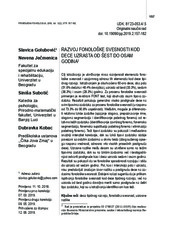Приказ основних података о документу
Development of phonological awareness in six to eight years old children
| dc.creator | Golubović, Slavica | |
| dc.creator | Ječmenica, Nevena | |
| dc.creator | Subotić, Siniša | |
| dc.creator | Kobac, Dubravka | |
| dc.date.accessioned | 2021-06-09T14:28:06Z | |
| dc.date.available | 2021-06-09T14:28:06Z | |
| dc.date.issued | 2019 | |
| dc.identifier.issn | 1821-0147 | |
| dc.identifier.uri | http://rfasper.fasper.bg.ac.rs/handle/123456789/1207 | |
| dc.description.abstract | The goal of the research is to determine the course of development of elements of phonological awareness and interaction between these elements in children with typical development. The sample included 60 children of both sexes (51.6% boys and 48.4% girls), ages of six (33.3%), seven (38.3%), and eight (28.3%) years. Phonological awareness was measured using the revised FONT test, which contains eight types of phonological tasks. The results show generally high achievement of children in all types of phonological tasks (success rates between 73.3% and 90.8%). However, it was possible to differentiate relatively easy tasks (blending syllables, identifying rhyming, syllable segmentation, and identifying initial phonemes) from relatively difficult tasks (phonemic segmentation, phoneme substitution (initial phoneme), and elimination of the initial phoneme). The more difficult types of tasks were more intensely inter-correlated, while easier types of tasks were less correlated with other tasks (due to narrowed range of the values, i.e., very high average scores). The age differences were observed only on more difficult tasks, while on the easier ones, even six-year-olds achieved scores comparable to older children. Functional mastering of the hardest phonological skills is established at the age of about seven years. Gender, as well as gender and age interactions, did not prove to be important sources of difference in phonological achievement. We suggest that when examining phonological awareness in children with typical development (who show no indications of language difficulties), even at the age of six years, it is sufficient to use only four types of tasks that we identified as relatively more difficult. | en |
| dc.publisher | Univerzitet u Novom Sadu - Filozofski fakultet - Odsek za psihologiju, Novi Sad | |
| dc.relation | info:eu-repo/grantAgreement/MESTD/Basic Research (BR or ON)/178027/RS// | |
| dc.rights | openAccess | |
| dc.rights.uri | https://creativecommons.org/licenses/by/4.0/ | |
| dc.source | Primenjena psihologija | |
| dc.subject | age differences | en |
| dc.subject | phonological awareness | en |
| dc.subject | typically developing children | en |
| dc.title | Development of phonological awareness in six to eight years old children | en |
| dc.type | article | |
| dc.rights.license | BY | |
| dc.citation.epage | 182 | |
| dc.citation.issue | 2 | |
| dc.citation.other | 12(2): 157-182 | |
| dc.citation.rank | M24 | |
| dc.citation.spage | 157 | |
| dc.citation.volume | 12 | |
| dc.identifier.doi | 10.19090/pp.2019.2.157-182 | |
| dc.identifier.fulltext | http://rfasper.fasper.bg.ac.rs/bitstream/id/180/1204.pdf | |
| dc.identifier.scopus | 2-s2.0-85075983444 | |
| dc.identifier.wos | 000473217000003 | |
| dc.type.version | publishedVersion |


